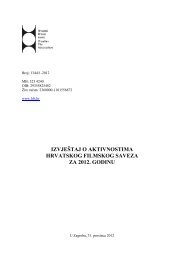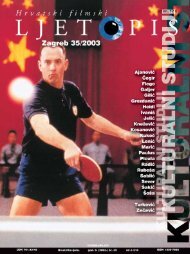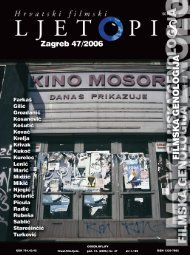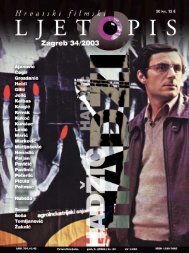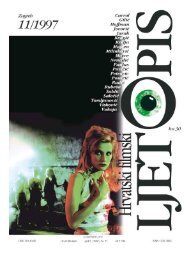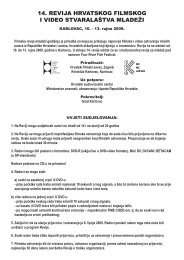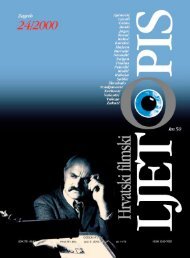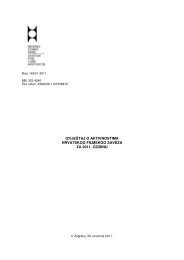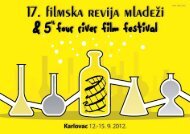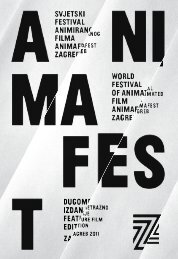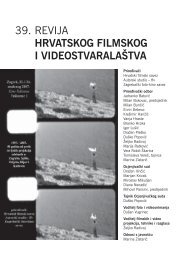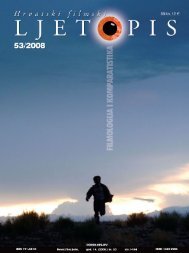Hrvatski filmski ljetopis, broj 15 (1998) - Hrvatski filmski savez
Hrvatski filmski ljetopis, broj 15 (1998) - Hrvatski filmski savez
Hrvatski filmski ljetopis, broj 15 (1998) - Hrvatski filmski savez
Create successful ePaper yourself
Turn your PDF publications into a flip-book with our unique Google optimized e-Paper software.
PORTRAIT<br />
UDC: 78.071:791.43(049)<br />
Irena Paulus<br />
A Bio-Filmographical Interview<br />
with Film-Music Composer<br />
An|elko Klobu~ar<br />
A conversation with composer An|elko Klobu~ar<br />
about his experience as a composer and conductor<br />
of film music.<br />
An|elko Klobu~ar first came into contact with film music at<br />
Dubrava film when he, as a musical advisor, added »background<br />
sound« to films shot without sound by using sounds<br />
and music from the archives at Dubrava film. The first films<br />
he composed music for were The Motorcycle Chase by B.<br />
Majer and the especially demanding film The Emperor’s<br />
New Cloths by A. Babaja. In addition to documentary and<br />
feature films, he composed music for the animated films of<br />
A. Marks, V. Mimica and Z. Bourek. His last film was The<br />
Stone Gates by A. Babaja. In the conversation, Klobu~ar gives<br />
advice for achieving stylistic features in music adapted<br />
for atmosphere effect, as well as his relationship with electronic<br />
tools that help in composing film music.<br />
UDC: 78.071:791.43(497.5)<br />
Irena Paulus<br />
An Organist in the Film Studio – An-<br />
|elko Klobu~ar and his Film Music<br />
An analysis of the film music of An|elko Klobu~ar<br />
in comparison to his organ music on the basis of<br />
differentiating works of popular musical expression<br />
based on musical tradition and composition<br />
with contemporary elements which adhere to the<br />
typical constants in Klobu~ar’s style.<br />
Composer, organist and music teacher An|elko Klobu~ar<br />
was born on July 11, 1931. He graduated from the music history<br />
department at Zagreb’s Music Academy and continued<br />
his studies in Salzburg and Paris. He composed with ease<br />
and his works encompassed almost all aspects of classical<br />
music. In spite of the fact that he wrote a large number of<br />
film scores, these compositions were overshadowed by his<br />
other works.<br />
According to Hana Breko’s analysis there are two groups of<br />
organ compositions by An|elko Klobu~ar in those works:<br />
compositions with a more popular musical expression<br />
which signify the composer’s return to third chords and musical<br />
tradition and those works with contemporary elements<br />
which adhere tot the typical constants in Klobu~ar’s style.<br />
By analyzing Klobu~ar’s film scores according to this division,<br />
we came to the conclusion that in spite of the necessary<br />
popular approach, some scores have more traditional elements<br />
while others highlight the elements of An|elko Klobu~ar’s<br />
typical style.<br />
Works that fall into the first group include the music for the<br />
feature length children’s film Chasing the Motorcycle, which<br />
is characterized by a very simple musical language, as well<br />
186<br />
<strong>Hrvatski</strong> <strong>filmski</strong> <strong>ljetopis</strong> <strong>15</strong>/<strong>1998</strong>.<br />
the more complex score of the feature film The Birch Tree,<br />
which is based on the folk song Slavuj pjeva. The music for<br />
the The Birch Tree joins together elements of both the old<br />
and new musical procedures.<br />
The music for the film The Emperor’s New Cloths links the<br />
stylistic trends of Romanticism, the Neorenaissance, Neoclassicism<br />
and the widened tonal system and in some way looks<br />
for a balance between the traditional and contemporary.<br />
Representing the contemporarily oriented film works is the<br />
score for the documentary film Ivan Me{trovi}. The film’s<br />
music is within the framework of the typical constants of<br />
Klobu~ar’s style (clearly formulated dispositions, fourth<br />
chords, additional seconds, etc.).<br />
The documentary film Antun Augustin~i} and the feature<br />
film The Secrets of NikolaTesla are also contemporarily oriented,<br />
but due to some elements (tonal experiments, musical<br />
sections with simple textures) there are boundaries between<br />
the first and second group.<br />
Since An|elko Klobu~ar wrote a large number of works for<br />
the concert podium on which he worked long and hard, it<br />
is not surprising that he considers his film music secondary<br />
and less important. However, the comparison between his<br />
film music and his organ works proves that there are portions<br />
of his film music which deserve serious analysis.<br />
CONTEMPORARY INTERPRETATIONS IN<br />
TRANSLATION<br />
UDC: 791.43(73)<br />
791.43:820-2<br />
Robert Benedetto<br />
A Streetcar Named Desire –<br />
Adapting the Play to Film<br />
The article states the requisite characteristics a play<br />
needs for its successful adaptation into a film. A<br />
case study of the William’s drama and Kazan’s film<br />
A Streetcar Named Desire.<br />
The basic characteristic is that a play’s story must take place<br />
in a realistic context and have the potential to be »opened<br />
up.« Tennessee Williams’ A Streetcar Named Desire is<br />
the kind of play that can be successfully translated into film<br />
and in 1951, under the direction of Elia Kazan, it was. The<br />
article presents a strong case to support the argument that<br />
the story of A Streetcar Named Desire is more effectively<br />
rendered as a film than as a play. In an interview, Kazan,<br />
agreeing with author Williams, stated, »the film version managed<br />
to surpass the effect of the play with the exception of<br />
the ending.« Forced to alter the original ending of the play<br />
to satisfy the industry censor, Kazan felt the story had been<br />
compromised. However, the article argues that the altered<br />
ending of the film version is more dramatically satisfying<br />
than the play’s ending, especially for a contemporary audience.<br />
In the play’s ending, Stella, after being brutalized by<br />
her coarse working-class husband, Stanley, docilely submits<br />
to him and his sexual advances. In the film’s ending, Stella<br />
makes a stand against Stanley, rejecting his advances, leaving



